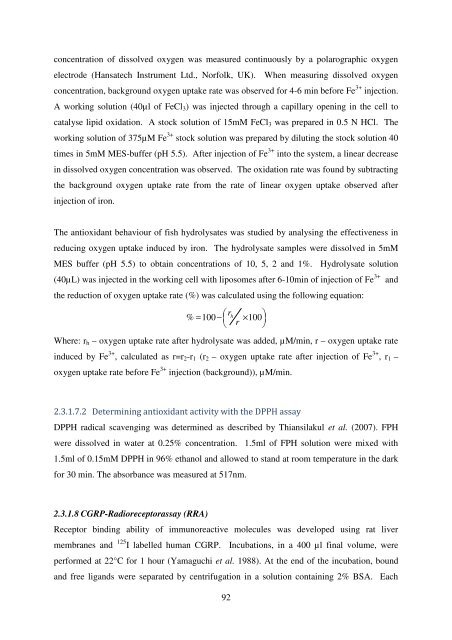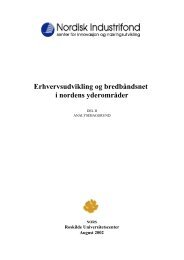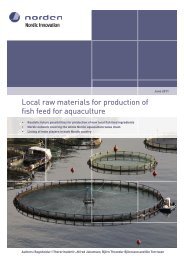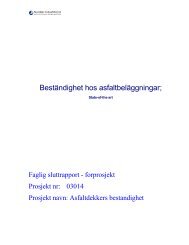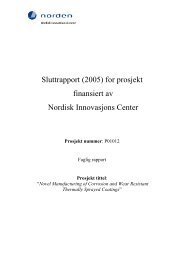Value added fish by-products - Nordic Innovation
Value added fish by-products - Nordic Innovation
Value added fish by-products - Nordic Innovation
Create successful ePaper yourself
Turn your PDF publications into a flip-book with our unique Google optimized e-Paper software.
concentration of dissolved oxygen was measured continuously <strong>by</strong> a polarographic oxygen<br />
electrode (Hansatech Instrument Ltd., Norfolk, UK). When measuring dissolved oxygen<br />
concentration, background oxygen uptake rate was observed for 4-6 min before Fe 3+ injection.<br />
A working solution (40µl of FeCl3) was injected through a capillary opening in the cell to<br />
catalyse lipid oxidation. A stock solution of 15mM FeCl3 was prepared in 0.5 N HCl. The<br />
working solution of 375µM Fe 3+ stock solution was prepared <strong>by</strong> diluting the stock solution 40<br />
times in 5mM MES-buffer (pH 5.5). After injection of Fe 3+ into the system, a linear decrease<br />
in dissolved oxygen concentration was observed. The oxidation rate was found <strong>by</strong> subtracting<br />
the background oxygen uptake rate from the rate of linear oxygen uptake observed after<br />
injection of iron.<br />
The antioxidant behaviour of <strong>fish</strong> hydrolysates was studied <strong>by</strong> analysing the effectiveness in<br />
reducing oxygen uptake induced <strong>by</strong> iron. The hydrolysate samples were dissolved in 5mM<br />
MES buffer (pH 5.5) to obtain concentrations of 10, 5, 2 and 1%. Hydrolysate solution<br />
(40µL) was injected in the working cell with liposomes after 6-10min of injection of Fe 3+ and<br />
the reduction of oxygen uptake rate (%) was calculated using the following equation:<br />
% = 100−<br />
⎛ ⎞<br />
⎜ × 100⎟<br />
⎝ r ⎠<br />
Where: rh – oxygen uptake rate after hydrolysate was <strong>added</strong>, µM/min, r – oxygen uptake rate<br />
induced <strong>by</strong> Fe 3+ , calculated as r=r2-r1 (r2 – oxygen uptake rate after injection of Fe 3+ , r1 –<br />
oxygen uptake rate before Fe 3+ injection (background)), µM/min.<br />
2.3.1.7.2 Determining antioxidant activity with the DPPH assay<br />
DPPH radical scavenging was determined as described <strong>by</strong> Thiansilakul et al. (2007). FPH<br />
were dissolved in water at 0.25% concentration. 1.5ml of FPH solution were mixed with<br />
1.5ml of 0.15mM DPPH in 96% ethanol and allowed to stand at room temperature in the dark<br />
for 30 min. The absorbance was measured at 517nm.<br />
2.3.1.8 CGRP-Radioreceptorassay (RRA)<br />
Receptor binding ability of immunoreactive molecules was developed using rat liver<br />
membranes and 125 I labelled human CGRP. Incubations, in a 400 µl final volume, were<br />
performed at 22°C for 1 hour (Yamaguchi et al. 1988). At the end of the incubation, bound<br />
and free ligands were separated <strong>by</strong> centrifugation in a solution containing 2% BSA. Each<br />
r h<br />
92


